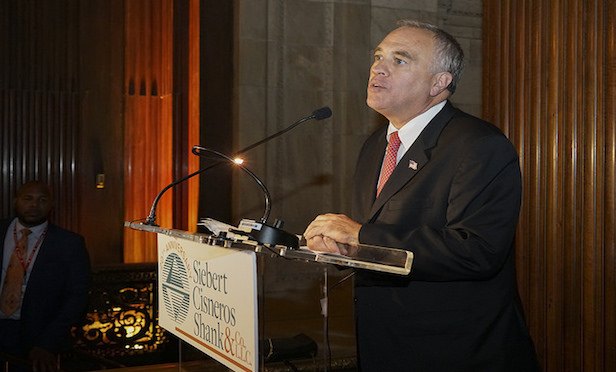 New York State Comptroller Thomas DiNapoli
New York State Comptroller Thomas DiNapoli
ALBANY—New York State Comptroller Thomas DiNapoli issued a sobering report on Friday of severe declines in state tax receipts for State Fiscal Year 2018-2019, which ended in March 2019.
The state ended its fiscal year on March 31 with a General Fund balance of $7.2 billion, which although higher than recent projections, was $2.2 billion lower than the prior fiscal year. DiNapoli states that tax receipts fell $3.7 billion or 4.7% for the entire fiscal year to $75.6 billion.
The state posted better than expected tax revenue in March, which were $811.7 million higher than the latest Division of the Budget (DOB) projections, released in February 2019. However, the state ended calendar year 2018 and began 2019 with sharp tax receipt declines in tax receipts in December and January that were a combined $3.2 billion below the earlier projections, primarily due to personal income taxes. With stronger-than-expected receipts in March, tax collections ended the fiscal year $601.4 million higher than DOB's February projections, but more than $2.3 billion lower than initially anticipated, with almost all of the variance in personal income tax.
Personal income tax receipts for the year totaled $48.1 billion, a decline of $3.4 billion, or 6.6%, from 2017-18, primarily due to a decrease in estimated payments. Consumption and use taxes rose to $17.4 billion, up $645 million, or 3.9%, from the previous year. Business tax receipts were $7.9 billion, an increase of 10.4%. Miscellaneous receipts totaled $31.2 billion, $3.2 billion more than initially planned, in part because of unanticipated monetary settlements of more than $1 billion. All Funds receipts for the year totaled $168.1 billion, including $61.3 billion in federal funds.
“After months of concern over lower-than-expected tax collections, the state ended the fiscal year on a positive note,” DiNapoli said. “The sharp revenue declines in December and January, however, remind us to take nothing for granted. With expectations of a slowing economy and ongoing concerns regarding federal fiscal policies, a strong commitment to building robust reserves in preparation for the next economic slump is essential.”
All Funds spending rose 4.4% to $170.9 billion, but was $856 million lower than DOB's latest estimate. The difference was primarily due to lower-than-anticipated spending for capital and departmental operations, offset by higher-than-anticipated spending for debt service, including prepayments made at the end of the fiscal year that totaled nearly $1.5 billion, according to the state's Department of Budget. Local assistance expenditures were $127.4 billion, up 4.5% while spending on departmental operations increased 1.1% compared to SFY 2017-18.
The $7.2-billion General Fund balance at the end of March was $1.7 billion higher than initially anticipated and $660.7 million higher than DOB's latest projection from February. A deposit of $250 million was made to the Rainy-Day Reserve Fund, bringing the combined total in the state's statutory rainy-day reserves (including the Tax Stabilization Reserve Fund) to $2 billion.
NYC Continues Record-Setting Job Growth Pace
The troubling state tax fiscal report followed a very positive report released earlier last week by the State Comptroller's Office on New York City's growing economy.
New York City employment reached 4.55 million jobs in 2018, the highest level ever recorded, according to the DiNapoli report.
“New York City is experiencing its largest and longest job expansion since the end of World War II and the city has been the driving force behind the state's employment gains,” DiNapoli said. “While job growth remains strong, there are national and global risks that could affect the pace of future growth.”
The city added 820,400 jobs between 2009 and 2018, more than every state in the nation outside of California, Texas, Florida and New York. Still, most of the jobs added were in employment sectors, such as leisure and hospitality, with average salaries below the citywide average of $89,800. In 2018, there were 721,800 more jobs in the city than before the recession.
The city's current job expansion is also the fastest, with an average of 91,200 jobs added each year. Business services, leisure and hospitality, and health care accounted for 60% of the gains since 2009.
The high-paying securities industry has also reported solid job gains in recent years, but is still 4% smaller than before the 2007 financial crisis.
The citywide unemployment rate fell from 10.1% in October 2009 at the height of the Great Recession to an annual rate of 4.1% in 2018, the lowest level since 1976 and only slightly higher than the national rate.
The business services sector, which includes accountants, lawyers, programmers and clerks, added the most jobs of any sector between 2009 and 2018 (193,000 jobs), an increase of 34%. That accounts for nearly a quarter of all jobs added during this period.
The leisure and hospitality sector grew the fastest (50%) and was responsible for nearly one-fifth of the citywide job gains—153,500. Restaurants were responsible for nearly two-thirds of the gains in this sector.
Health care, the only employment sector to add jobs every year since 1990, added 145,500 jobs from 2009 to 2018. It was also responsible for the most job gains in any sector in 2018.
The technology sector has grown by 80% since 2009 to 142,600 jobs. With an average salary of $152,900 in 2017, the tech sector has become one of the economic drivers in New York City.
As a result of strong job growth in the outer boroughs, Manhattan's share of private sector employment has declined, from 64 %in 1990 to 59% in 2018. Brooklyn's share increased the most, rising from nearly 13% to 17%.
© Touchpoint Markets, All Rights Reserved. Request academic re-use from www.copyright.com. All other uses, submit a request to [email protected]. For more inforrmation visit Asset & Logo Licensing.







